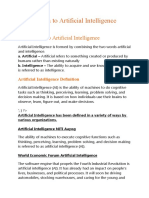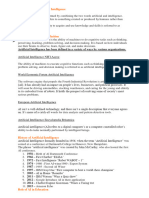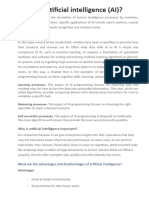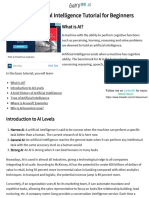0% found this document useful (0 votes)
54 views16 pagesChapter 1 Notes
The document provides an introduction to Artificial Intelligence (AI), defining it as the ability of machines to perform cognitive tasks similar to human intelligence. It covers the history, applications, and various branches of AI, including machine learning, natural language processing, and robotics, as well as its role in education and sustainable development. Additionally, it discusses the ethical considerations and career opportunities in the field of AI.
Uploaded by
sandrakurup2008Copyright
© © All Rights Reserved
We take content rights seriously. If you suspect this is your content, claim it here.
Available Formats
Download as PDF, TXT or read online on Scribd
0% found this document useful (0 votes)
54 views16 pagesChapter 1 Notes
The document provides an introduction to Artificial Intelligence (AI), defining it as the ability of machines to perform cognitive tasks similar to human intelligence. It covers the history, applications, and various branches of AI, including machine learning, natural language processing, and robotics, as well as its role in education and sustainable development. Additionally, it discusses the ethical considerations and career opportunities in the field of AI.
Uploaded by
sandrakurup2008Copyright
© © All Rights Reserved
We take content rights seriously. If you suspect this is your content, claim it here.
Available Formats
Download as PDF, TXT or read online on Scribd
/ 16





































































































